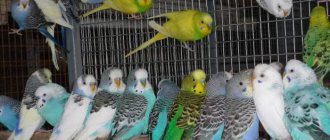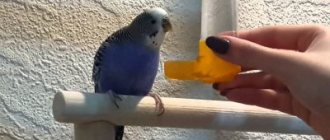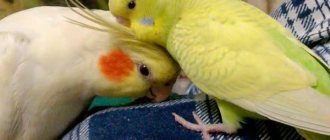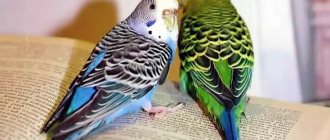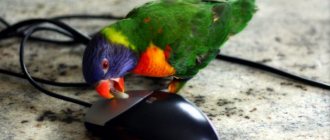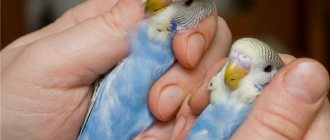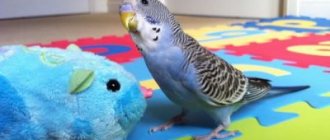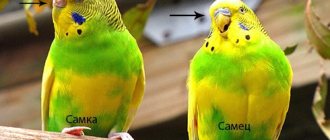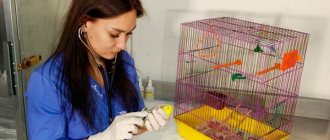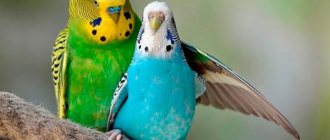Many people keep budgies at home - their care is minimal, but the emotional return is enormous. Before buying, the future owner thinks about how to choose the best budgie: healthy, young, and able to talk. After reading the article, you will learn about all the subtleties: what questions to solve initially, what places sell good birds, what a budgie should look like. And the last thing is what you need to do when you take your baby home, how to help him survive the adaptation.
How to prepare to buy a parrot
Getting a small parrot is as easy as shelling pears: now pet stores are full of different birds, food, and accessories for keeping them. The prices for all this stuff are affordable. Before you start choosing a parrot for your home, you need to think things through. It’s worth discussing your wishes with your family and not forgetting a single detail:
- Watch the video. Even little ones like wavy creatures litter and make noise. They wake up at dawn and chirp all day. Flying around the apartment, they leave droppings behind them, tear off wallpaper and curtains. They spoil documents, books, gnaw flowers.
- Evaluate the space. Select the location where the cage will be located. The wavy does not need a large home, but it still needs freedom. The maintenance rules stipulate that the cage should be kept away from windows, batteries and household appliances. At the same time, parrots do not like to be moved from place to place. Birds should have a permanent corner.
- Make time. Sociable birds require attention; they get bored without people. If you don't have even one free hour a day to talk to, pet, and train your parrot, don't get a pet. Loneliness and then depression await him.
- Select the sex and number of birds. With plenty of time to spend, take one wavy boy. Males learn better and imitate speech. Females are shy and less attached to their owner. Two same-sex birds often quarrel, while opposite-sex birds create a family and raise chicks.
- Collect a first aid kit. It’s not enough just to provide care items and medications; you also need to write down the address and telephone number of the nearest veterinary clinic. The feathered ward will have to be treated, vaccinated, and taken for preventive examinations.
Attention! The down and feathers of budgies provoke an allergic reaction. If anyone in your family is prone to allergies, do not buy the bird.
When all the pros and cons are weighed, and the decision is made that you are buying wavy, it’s time to go to the trading places.
Where to buy a budgie
You can buy a budgie from amateur breeders or at retail outlets:
- in a pet store;
- from a professional breeder;
- by advertisement;
- in a specialized club;
- at the poultry market.
Buying a budgie from a pet store is the easiest option. There are always birds of different colors there. Usually chicks bred at home are sold there. The seller will help you figure out how to choose the right pet parrot. He will tell you about the needs of the bird and recommend equipment. Conscientious traders value the store's reputation and take good care of the birds and do not allow the cages to become overcrowded. If you're lucky, the seller will recommend an individual that's right for you.
A breeder is a person who breeds birds professionally. He knows thoroughly the positive and negative sides of the chick, and can tell everything about health, behavior and possible problems. He will show the parents, name their age and gender. Often, breeders monitor the fate of sold parrots and offer their phone number for consultation.
Attention! When buying a bird from an advertisement, you risk getting a sick, old or malignant bird with which the previous owners did not get along.
In specialized nurseries and clubs, chicks with interesting colors or show ones are often chosen. Here you will find out the exact age of the bird and its origin. Such parrots have a pedigree, a permanent ring, and a corresponding price.
The poultry market should be considered last. In such places, birds live in cramped conditions and dirt. They are poorly cared for due to the huge number of individuals. In such conditions, you may unexpectedly buy a sick parrot. In order not to take a “pig in a poke,” you need to know the signs of a painful condition and imagine the appearance of a healthy wavy.
What does a healthy bird look like?
A sick parrot is not as scary as you might think. But you cannot bring a sick individual into a house where other birds live - it will infect everyone. So how to choose and buy a healthy parrot? Carefully consider his appearance and behavior. Indicators of a successful bird:
- shiny, dense plumage;
- eyes are clean, not cloudy;
- cere without cracks and growths;
- smooth, clean beak;
- smooth skin on the paws;
- proud posture;
- The cloaca area is neat, covered with feathers.
A well-groomed parrot should be well-fed and active. When sitting on a perch, the paws are spread wide and grasp firmly with four toes. If there have been injuries, fractures, the bird has difficulty maintaining its balance and walks awkwardly.
Assessing the external condition of the bird before purchasing
When you choose a parrot, be guided not by feelings and emotions, but by common sense and the information that is worth studying before buying a pet.
General view of the parrot
The bird should be active and have bright plumage. Choose a parrot that shows a clear interest in everything that happens around it. If there are other birds in the cage, pay attention to their behavior. It is better to buy a parrot that occupies a dominant position. You should not buy a lethargic, inactive pet that is offended by other birds.
Plumage
It is worth paying attention not only to the brightness of the plumage, but also to the general condition of the wings, which should not be clipped. Also look at the cleanliness and smoothness of the feathers. They should fit neatly to the entire surface of the bird’s body. A healthy parrot does not have bald spots. The exception is the molting period, when characteristic “stumps” appear in place of missing feathers. If there are open areas of the body, they should not show ulcers or other signs of injury. Unscrupulous sellers claim that young parrots have ruffled plumage and look unkempt. But this is absolutely not true. The young bird has clean and smooth feathers that fit tightly to the body. Chicks that are not fully fledged look disheveled.
Breath
A healthy bird breathes slowly and evenly. Disturbances in the respiratory system can be detected by careful examination of the pet. He should not open his beak while breathing. Also abnormal is the presence of wheezing and whistling. This indicates that the parrot is sick.
Eye condition
The parrot's eyes are shiny and clean, its gaze is active. The bird should not have sore eyelids, scales or any signs of damage. What should alert you is that the bird has a dull, squinted gaze - this indicates the parrot’s painful condition and the progression of dangerous infectious diseases.
Beak, nostrils and cere
The parrot's beak has a normal shape, without asymmetrical areas. It should be clean and shiny, without pronounced growths and cracks. Pay attention to the cere. It should be smooth, without damage or roughness. There is no suspicious discharge in the nostrils of a healthy parrot.
Paws
A parrot's feet are often damaged due to improper care and selection of a traumatic cage. There should be no damage or growths on them. A healthy pet's claws are clean and shiny. Fingers should not be crooked. Take a closer look at how the bird moves. She shouldn't limp.
Condition of droppings and cloaca
The health of a parrot can be determined by the state of its droppings. It should be well formed and quite dense. When feeding your pet juicy food, liquid droppings may appear for a short time. In this case, look at the cloaca. It should be clean, without signs of discharge or contamination. If the anal protrusion is inflamed and swollen, the parrot is definitely sick.
Breastbone and abdomen
A healthy parrot has a normal sized breast bone. It should not stand out noticeably. The bird's abdomen in normal condition is slightly retracted, does not sag or protrude.
What is the difference between a chick and an adult?
Ornithologists recommend choosing a budgerigar no older than six months. The growing chick has a flexible psyche, it is easier to tame, and quickly gets used to its new home. In order for your parrot to speak, you need to start training it as early as possible. How to avoid making a mistake with age when purchasing?
Signs of young individuals:
- clear waves on the back and head from the cere. After the first molt, the feathers from the crown to the back of the head acquire one color, without inclusions or patterns;
- black spots on the beak, dark irises, without rings;
- short tail;
- matte shade of feathers, without shine.
You need to examine the bird in the company of relatives. By comparing different individuals, you are more likely to select a young parrot.
Documents for a parrot
According to current legislation, the sale of live animals is possible only if there are accompanying veterinary documents. Documents are usually issued for the entire consignment of live goods, i.e., for example, for 100 heads of budgerigars. A document is not issued for each parrot from this batch. So the only legal document is the check you receive. When selling, you can request an extract of a sales receipt, which will indicate the type of animal. Save your documents! Although animals are non-exchangeable items, if illness occurs prior to purchase, you may be able to request a refund. But to prove that the animal was sick before purchase, you will need to conduct a veterinary examination. So carefully consider all the parrots offered for purchase.
How many parrots to buy
The number of birds depends on the goals and capabilities of the breeder. If you are choosing a companion who will brighten up your loneliness, it is better to take one talking parrot. Constant communication and care will allow the new pet to become a full member of the family over time. Connoisseurs of silence are advised to get a girl budgerigar, since females are less noisy than males.
If the owners are not home much, the lonely bird begins to feel sad. You can save your feathered ward from sadness by choosing company for him. Two or three individuals can live in one spacious cage. Well, if you have plans for breeding, buy a female and a male at once.
Attention! It is not advisable to buy two parrots in one place: a pair of opposite sexes may be from the same parents. Reproduction of closely related birds leads to degeneration of the breed and the appearance of offspring with developmental defects.
How to choose a male budgie
Male budgerigars are more often adopted: it is believed that they are more active, cheerful, and easier to tame. It is easier to teach a boy to speak, and the ability to imitate human speech is one of the most attractive qualities.
Often gender is quite obvious. Females and males do not differ particularly in plumage; the main external sexual characteristic is the color of the wax. In mature females it is brown or beige, in males it is purple. In young birds that have not gone through the molting stage, gender is diagnosed with low probability. Even the seller cannot always tell you exactly.
Note: a wavy boy can be recognized by observing his behavior. The male will sing a lot, shake his wings frequently, and sit on top of other birds.
Who and how many to choose
How many parrots to buy for your home is everyone’s choice, based on their capabilities and preferences. If you have prepared a small cage at home, then you should not put more than 1-2 individuals in it. In nature, these birds choose a partner and remain faithful to him until the end of their days.
The purchased parrot gradually gets used to the person and to communicating with him. You need to devote time to it every day, at least 15–20 minutes. Without attention, the bird becomes sad and stops talking, then begins to look for something to do on its own. Lack of attention from the owner makes the parrot wild, and some individuals may even get sick.
Important! If family members do not have enough time, it is better to purchase several parrots.
In order for your budgie to speak, it is recommended to choose a young male. They are more talkative, cheerful and friendlier than females. They also have good learning ability. Females are less sociable, sometimes even aggressive, and difficult to train.
Sexual characteristics are noticeable only in adult birds. The boy's budgerigar has a purple cere, while the girl's is light brown. Before molting, it is almost impossible to determine the gender by external signs. Even experienced poultry keepers cannot determine it with accuracy. There are only some differences in behavior: males sit on top of other birds and sing a lot. Females make few sounds.
How to find a talking parrot
Budgerigars are able to remember words that a person says and reproduce them without reference to the situation. What to look for and how to choose a budgie to talk to?
- Gender is important: boys learn faster and speak more willingly than girls.
- Good health - an active and cheerful bird is in the mood for chatter.
- The young chick becomes strongly attached to its owner and trusts him boundlessly.
- Individuals with natural colors are the most talkative. Rare mutations, especially albinos, have difficulty speaking.
- Weak chicks abandoned by their parents are the best students. Growing up under the care of a “nanny,” they absorb information and begin to speak early.
Gender, age, health are the main criteria for learning ability. Boys aged 8 - 10 months are ideal for training. It turns out that choosing a parrot to talk to is not so difficult. Affectionate treatment will help consolidate the results.
Choosing a parrot to talk to
These birds are the only birds that can speak well. Some species even have a flat tongue, which is capable of perfectly repeating entire meaningful phrases. The most susceptible breeds of parrots to training are macaws, grays and cockatoos. But they tend to be quite expensive. But a budgie or cockatiel are much cheaper, but they can just as entertain with conversation. If a chick, one to three months old, is immediately trained after acquisition, then after two to three months it will begin to reproduce the first phrases. Conditions for choosing a budgie for conversation:
- the chick must be taken at one month of age;
- A green or blue male is better for conversation. For some reason, birds of a different color learn somewhat worse;
- females are also capable of pronouncing words, but their speech capabilities are much lower;
- It is better to buy a male without a mate because, having a living girlfriend in sight, the parrot will not want to communicate with the owner using human speech.
Which parrot should you not take?
There are certain points in the behavior of birds that should alert you. When choosing, pay special attention to the following nuances:
- discharge from the nostrils is a consequence of a cold, runny nose or serious illness;
- the parrot itches a lot not only with its beak, but also with its claws - there are parasites on the skin and feathers;
- chips on the beak and growths on the cere are health problems.
A moderately timid parrot is normal; the instinct of self-preservation makes it afraid of everything unfamiliar. But if a bird fights in horror when a person approaches the cage, this is how mental disorders manifest themselves. Such an individual is difficult or impossible to tame.
Is it worth having a parrot in an apartment?
The parrot is one of the most popular pets. Keeping an animal has both pros and cons.
Some of the benefits of keeping birds as pets include:
- Lack of odor compared to other animals.
- Opportunity to have fun by learning to talk and do tricks.
- There is no need for walking.
- Low maintenance requirements.
- No need for human participation in hygiene procedures.
- Small individuals do not require large housing space.
- Consumption of small amounts of feed.
- Rarely affected by diseases.
There are not too many disadvantages of keeping parrots. These include:
- The need to periodically release birds from the cage to fly, during which they can cause damage to things and indoor plants.
- Many species have an unpleasant voice and are very noisy.
- The owner needs to pay a lot of attention so that the bird does not get bored, feel lonely or become depressed.
Find out in more detail whether it is worth getting a parrot, the pros and cons of keeping it.
How to help a bird adapt
So, the budgie was selected, purchased and delivered to the apartment inside a carrier. Now you need to carefully move it into the prepared cage. To do this, place the portable box next to the cage and align both open doors. It is necessary to pay attention: you cannot catch the bird and move it to a permanent home. Don't let him fly freely around the room. Be patient, otherwise the frightened bird will not be able to trust you for a long time.
Upon entering the cage, the parrot will discover the amenities you have created: feeders, various climbing devices, and seats. At first, he will hide from prying eyes in containers. Place a grain mixture and fresh twigs in the feeders in advance so that a hungry baby has something to do.
For the first two weeks, do not walk your new pet, do not disturb him again, and clean up the cage less often. Let the chick get used to the environment, new sounds and objects, and people's voices. Do not allow pets into the room, protect the parrot from flashes of light, create a suitable microclimate. Address the wavy kindly, call him by name.
Noticing that your ward is showing friendliness, let him out for a walk. Before doing this, secure the room as much as possible, close the doors and windows. Normally, the adaptation period ends when the bird calmly sits on the shoulder or finger of its owner. After this, consider that contact has been established.
Choosing a budgie is an important and difficult task. With proper care, a small feathered pet will live with you for ten years or even more. Decide in advance how many birds you need, what gender and age. Go to a reputable breeder to ensure you get healthy parrots.
